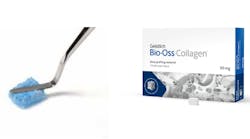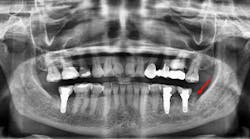Bone regeneration through tissue engineering offers new prospects for oral procedures
Regeneration of bone tissue could greatly benefit people with jawbone deficiencies due to tooth loss, infection, or trauma. While an ideal method of bone tissue engineering is not yet available, research with a collagen-hydroxyapatite-mesenchymal stem cell composite is showing promise.
ADDITIONAL READING |Guided tissue regeneration: background to current indications and applications
Hydroxyapatite is the main component of bone mineral and tooth enamel. A report in the Journal of Oral Implantology details researchers’ efforts to synthesize a collagen-hydroxyapatite composite through mineralization of collagen fibrils with nanometer-sized apatite crystals. The biological properties of the composite were evaluated by culturing with mouse and human mesenchymal stem cells.
Currently, the methods of bone repair and regeneration include the following bone graft types:
• Autografts: grafting bone from the same person
• Allografts: taking bone tissue from another person
• Xenografts: collecting material from a nonhuman species
• Alloplasts: using synthetic materials
Each of these methods has limitations that tissue engineering involving scaffolds and living cells can surpass.
The scaffold is an artificial structure that is combined with living mesenchymal stem cells to form a tissue engineering construct that can repair or regenerate bone. Mesenchymal stem cells, which can differentiate into a variety of cell types, are used to precipitate bone growth.
The current study tested three ratios of collagen to hydroxyapatite: 80:20, 50:50, and 20:80. Both the 80:20 and 50:50 composites supported attachments and proliferation of mouse mesenchymal stem cells and human periodontal ligament stem cells in laboratory tests. The 50:50 ratio had the best mechanical properties suitable for bone grafting applications.
View the abstract.
View the PDF.
The authors report that these findings indicate a strong potential for collagen-hydroxyapatite composite complexes in bone tissue regeneration. The composites are porous and sponge-like, and show good biocompatibility and biomimetric properties.
Alveolar bone deficiency is a limiting factor for dental implant-supported prosthetic therapies. The effective formation of new bone offers a basis for further procedures to successfully repair teeth and jaws.
Full text of the article, “Porous Collagen-Hydroxyapatite Scaffolds With Mesenchymal Stem Cells for Bone Regeneration,” Journal of Oral Implantology, Vol. 41, No.1, 2015, is available here.
The Journal of Oral Implantology is the official publication of the American Academy of Implant Dentistry. For more information about the Journal of Oral Implantology, please visit their website.

